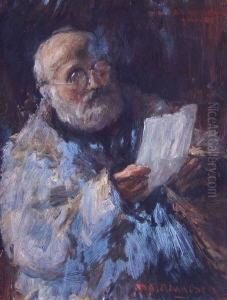Albert Mannchen Paintings
Albert Mannchen was a notable German sculptor and printmaker born in 1885. His artistic journey began in the early 20th century, a period that witnessed remarkable shifts in the landscape of European art, with movements such as Expressionism, Cubism, and Dada reshaping traditional notions of form, space, and subject matter. Mannchen's work, deeply influenced by these avant-garde movements, particularly Expressionism, exhibited a profound engagement with the human condition, marked by a distinctive stylization of figures and a potent emotional intensity.
Mannchen’s artistic career was largely shaped by the socio-political upheaval of his times. The early decades of the 20th century were tumultuous, with the First World War and the subsequent socio-political changes in Germany profoundly affecting the artist’s thematic preoccupations and stylistic approaches. His sculptures often depicted the human body in ways that emphasized emotional distress, reflecting the broader existential concerns of the era. Similarly, his prints, characterized by stark contrasts and bold lines, delved into themes of struggle, despair, and the absurdity of the human condition, resonating with the Expressionist fascination with the darker aspects of human psyche and society.
Despite his significant contributions to early 20th-century German art, Mannchen's work has not achieved the same level of recognition as some of his contemporaries. This oversight can be attributed, in part, to the overshadowing impact of more prominent figures within the Expressionist movement and the subsequent shifts in artistic trends that favored abstract and conceptual art forms. His death in 1935 meant that he did not witness the further transformations of the art world in the wake of the Second World War and beyond, which saw the center of the art world shift from Europe to America and the rise of new movements such as Abstract Expressionism.
Moreover, the rise of the Nazi regime in Germany, which branded much of the avant-garde art as 'degenerate', led to a further marginalization of artists like Mannchen, whose works might have been deemed antithetical to the aesthetic and ideological preferences of the regime. The post-war period, with its emphasis on rebuilding and redefining German identity, also contributed to the neglect of certain artists from the earlier part of the century, as cultural and artistic priorities shifted.
Today, Albert Mannchen's legacy is being gradually reassessed, with art historians and curators recognizing the depth and intensity of his contributions to modern art. His sculptures and prints offer a poignant reflection of the human experience during one of the most turbulent periods in history, making them not only significant within the context of German Expressionism but also relevant to contemporary explorations of identity, conflict, and resilience.
